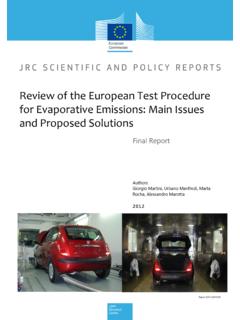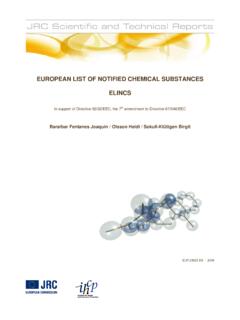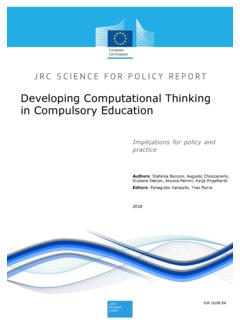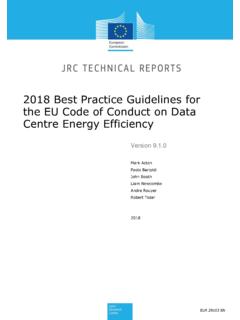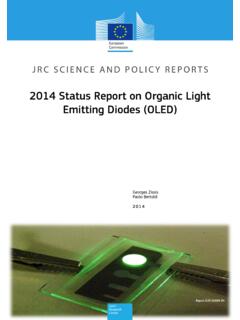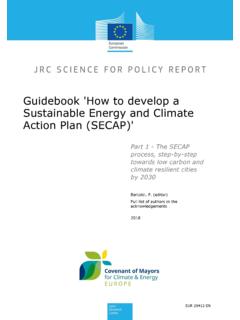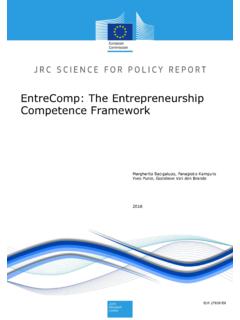Transcription of GREENHOUSE GAS EMISSIONS FROM FOSSIL FUEL FIRED …
1 GGGRRREEEEEENNNHHHOOOUUUSSSEEE GGGAAASSS EEEMMMIIISSSSSSIIIOOONNNSSS FFFRRROOOMMMFFFOOOSSSSSSIIILLL FFFUUUEEELLL FFFIIIRRREEEDDD PPPOOOWWWEEERRR GGGEEENNNEEERRRAAATTTIIIOOONNNSSSYYYSSST TTEEEMMMSSSM. STEENDG-JRC/IAMEUR 19754 ENEUROPEAN COMMISSIONJOINT RESEARCH CENTRE (DG JRC)INSTITUTE FOR ADVANCED NOTICEN either the European Commission nor any personacting on behalf of the Commission is responsible for the usewhich might be made of the information offered in this Gas EMISSIONS from FOSSIL Fuel FIRED Power Generation Systems 3/61 The Energy Technology Observatory (ETO) at the Institute for AdvancedMaterials of the DG-JRC focuses on technology aspects of powergeneration and conversion at large. In line with the mission statement ofthe JRC it provides objective and independent support to the EU policy-maker on power generation issues with emphasis on environment andsustainable growth aspects.
2 Its work is carried out in close relationshipwith all stakeholders and with other Institutes of Gas EMISSIONS from FOSSIL Fuel FIRED Power Generation Systems 4/61 TABLE of CONTENTSEXECUTIVE SUMMARY5 Issue71. Distribution of GHG EMISSIONS and their sources72. EMISSIONS stemming from energy generation93. EMISSIONS from FOSSIL fuel FIRED power relative contribution of generation technology and fuel Fuel mix: effect of carbon Thermal Coal- FIRED Natural Gas Power Comparison coal and Combined heat and power (CHP)224. Evolution trend of CO2 EMISSIONS from FOSSIL -fuel FIRED power changes in energy consumption for power changes in emissions295. Mitigation of CO2 Overall mitigation possibilities and Emission reduction potential in the European Union336. Emission Abatement Abatement cost Cost analysis and specific emission reduction costs in power CO2 removal and storage costs417.
3 Reduction potential and cost in the EU energy supply sector, excl. sequestration 43 Annex A: Pollutants from power generation47 Annex B: Cost Fixed Investment Fixed operating and maintenance Variable Levelised electricity cost for new External costs54 Annex C56 GREENHOUSE Gas EMISSIONS from FOSSIL Fuel FIRED Power Generation Systems 5/61 GREENHOUSE GAS EMISSIONS FROM FOSSIL FUELFIRED POWER GENERATION SYSTEMSEXECUTIVE SUMMARYW hile high EMISSIONS of GREENHOUSE gases (GHG) are a recognised threat to the stabilityof the earth s climate, global anthropogenic GHG EMISSIONS continue to rise. The prudentresponse to climate change is to adopt a portfolio of actions aimed at mitigation,adaptation, and research. The present document aims at identifying effective technicalmeasures for mitigation of GHG EMISSIONS in the EU, particularly in view ofcomplying with the Kyoto Protocol on a review of the distribution and sources of GHG EMISSIONS , it appears that byfar the largest contribution to the GREENHOUSE effect stems from EMISSIONS of carbondioxide CO2.
4 In turn, 75% of the global CO2 EMISSIONS result from the combustion offossil fuels for the transformation and use of energy. This indicates that FOSSIL fuelcombustion is the largest single contributor to the GREENHOUSE the EU power generation and transport each account for approximately one thirdof CO2 EMISSIONS from FOSSIL fuel combustion, whereas the remaining third mainly comesfrom industry and domestic heating. Because flue gas streams from thermal power plantsare large and few in number, whereas emission sources in the other sectors are many,small and dispersed, technological measures to reduce EMISSIONS from powergeneration have the greatest impact, both in terms of their efficiency and of the volumeof the reduction EMISSIONS from power generation are influenced by two factors, namely the carboncontent of the fuel and the overall conversion efficiency.
5 Technological measures toreduce EMISSIONS primarily aim at increasing the thermal efficiency, a stillinsufficiently exploited route. Substantial efficiency increases can be realised throughthe use of clean combustion technologies, and combined cycle operation. OptimumGreenhouse Gas EMISSIONS from FOSSIL Fuel FIRED Power Generation Systems 6/61exploitation of these approaches is expected to lead to efficiencies of up to 65% (morethan a 50% relative increase from the current average thermal power generationefficiency in the EU), and concomitant CO2 reductions in the range 40-50% from currentlevels. Further overall efficiency increases are possible by new advanced cycles, and on recent projections showing rather low penetration rates of zero carbon contentfuels (nuclear and renewable energy sources), CO2 emission abatement in the near futurewill increasingly rely on measures that reduce energy intensity and specific energyconsumption, increase efficiency.
6 Beyond 2010 electricity and steam generationare projected to contribute most to the increase in CO2 EMISSIONS from all sources,highlighting the extreme importance of measures to increase thermal efficiency tocounter this meet the EU s Kyoto target, an annual total reduction of 650 Mt is required,of which 400 Mt CO2/yr from energy-related sectors. Based on several emissionabatement studies, this corresponds to an economical cost of around 100 90/tC, or 27 90/tCO2 (in current value 37 /tCO2). Cost evaluation of emission reduction options fromdifferent sources reveals that for this level of abatements cost more than 60% of all CO2emission reduction is achieved in the power generation order to quantify CO2 emission reduction costs for a number of thermal powergeneration technologies, a spreadsheet programme has been developed that allowscalculation of the levelised electricity generation and the specific CO2 reduction costs.
7 Incombination with quantitative assessments of the emission reduction potential offered bydifferent technology options, a marginal cost abatement curve for the energy supplysector in the EU has been established and compared to projections from other Gas EMISSIONS from FOSSIL Fuel FIRED Power Generation Systems 7/61 GREENHOUSE GAS EMISSIONS FROMFOSSIL FUEL FIRED POWER GENERATION SYSTEMSI ssueGlobal warming is a recognised threat to the stability of the earth s climate. The only wayto control global warming is to control the concentration of GREENHOUSE gases in theatmosphere. There are but two ways to do this: (1) substitute high-carbon fuels with lowor no-carbon fuels; (2) produce and use energy more the conference of the parties (CoP) in Kyoto in December 1997, the EU agreed toreduce EMISSIONS of six GREENHOUSE gases by 8% of 1990 levels by 2010.
8 This constitutesa specific challenge for EU energy policy as some 80% of the EU s total GREENHOUSE gasemissions originate from energy document outlines first the dependence of GREENHOUSE gas EMISSIONS from the powergeneration sector on FOSSIL fuel mix and on efficiency, and subsequently discussesemission abatement potentials and the associated Distribution of GHG EMISSIONS and their sourcesThe major Kyoto GREENHOUSE gases are CO2, CH4, and N2O which emanate from bothenergy and non-energy sources. Also included are hydrofluorocarbons, perfluorocarbonsand sulphur hexafluoride, which have relatively high global warming potentials but areemitted in small volumes and are for the most part not energy-related. The greenhouseeffect of the different gases is expressed as CO2 equivalent, based on a similar globalwarming (GW) potential over a 100-year 1: Global warming potentials [1]Gasglobal warming potential for various time horizons20 years100 years500 on the amount of gas emitted and the GWP, the contribution of differentgreenhouse gases to global warming for the EU in 1990 is shown in Fig.
9 1. Althoughthere is agreement between different sources on the share of individual GHGs, the valueof the total EMISSIONS ranges from 3938 Mt CO2-eq. [28, p. 64] over 4292 Mt CO2-eq.[33, vol. 11, p. 16] to 4334 Mt CO2-eq. [30]. GREENHOUSE Gas EMISSIONS from FOSSIL Fuel FIRED Power Generation Systems 8/61 EMISSIONS based on GWP by type of gas, EU, 1990 HFC+PFC+SF62%N2O8%CH411%CO279%Fig. 1 [30]In a similar way fig. 2 represents the situation of the US in 1998 (total Gt C, typicalfor industrialised regions in the world). EMISSIONS based on GWP by type of gas, US, 1998 HFC+PFC+SF62%N2O6%CO283%CH49%Fig. 2 [2, p. 310]From these figures it appears clearly that by far the largest contribution to thegreenhouse effect stems from EMISSIONS of CO2. Among the other GREENHOUSE gases, theemissions of methane and nitrous oxide in recent years have remained stable or tend todecrease [2, table ].
10 Moreover, in compliance to the Montreal Protocol, halogenatedGreenhouse Gas EMISSIONS from FOSSIL Fuel FIRED Power Generation Systems 9/61gases (HFC, PFC, SF6) are being phased out because of their role in destroying the two major anthropogenic (human activity induced) sources of CO2 EMISSIONS world-wide are the combustion of FOSSIL fuels and land-use changes, mainly , approximately 75% of global CO2 EMISSIONS result from FOSSIL fuel combustionfor the transformation and use of energy, although the share varies by region [3, p. 155].Therefore, the energy sector has to be considered as the central point of any emissionreduction the following attention is focused on EMISSIONS from the energy sector with particularemphasis on FOSSIL fuel combustion for energy-related EMISSIONS stemming from energy generationThe origins of CO2 EMISSIONS from FOSSIL fuel combustion in the EU are shown in Fig.
